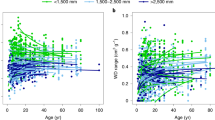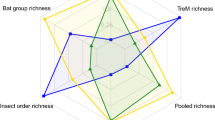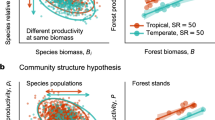Abstract
Forest restoration increases global forest area and ecosystem services such as primary productivity and carbon storage. How tree species functional composition impacts the provisioning of these services as forests develop is sparsely studied. We used 10-year data from 478 plots with 191,200 trees in a forest biodiversity experiment in subtropical China to assess the relationship between community productivity and community-weighted mean (CWM) or functional diversity (FD) values of 38 functional traits. We found that effects of FD values on productivity became larger than effects of CWM values after 7 years of forest development and that the FD values also became more reliable predictors of productivity than the CWM values. In contrast to CWM, FD values consistently increased productivity across ten different species-pool subsets. Our results imply that to promote productivity in the long term it is imperative for forest restoration projects to plant multispecies communities with large functional diversity.
This is a preview of subscription content, access via your institution
Access options
Access Nature and 54 other Nature Portfolio journals
Get Nature+, our best-value online-access subscription
$29.99 / 30 days
cancel any time
Subscribe to this journal
Receive 12 digital issues and online access to articles
$119.00 per year
only $9.92 per issue
Buy this article
- Purchase on Springer Link
- Instant access to full article PDF
Prices may be subject to local taxes which are calculated during checkout




Similar content being viewed by others
Data availability
The stand-level tree volume data supporting the findings of this study are available at https://data.botanik.uni-halle.de/bef-china/datasets/640. The species trait data supporting the findings of this study are available at https://data.botanik.uni-halle.de/bef-china/datasets/645.
Code availability
The R code used to create the metadata and perform analyses is available at https://github.com/fjbongers/FD-effects-with-stand-age.
References
Global Assessment Report on Biodiversity and Ecosystem Services (IPBES, 2019).
Bastin, J. F. et al. The global tree restoration potential. Science 366, 76–79 (2019).
Griscom, B. W. et al. Natural climate solutions. Proc. Natl Acad. Sci. USA 114, 11645–11650 (2017).
Zhang, J., Fu, B., Stafford-smith, M., Wang, S. & Zhao, W. Improve forest restoration initiatives to meet Sustainable Development Goal 15. Nat. Ecol. Evol. 5, 10–13 (2021).
Holl, K. D. & Brancalion, P. H. S. Tree planting is not a simple solution. Science 368, 580–581 (2020).
Lewis, S. L., Wheeler, C. E., Mitchard, E. T. A. & Koch, A. Restoring natural forests is the best way to remove atmospheric carbon. Nature 568, 25–28 (2019).
Messier, C. et al. For the sake of resilience and multifunctionality, let’s diversify planted forests! Conserv. Lett. https://doi.org/10.1111/conl.12829 (2021).
Baeten, L. et al. Identifying the tree species compositions that maximize ecosystem functioning in European forests. J. Appl. Ecol. 56, 733–744 (2019).
Schuldt, A. et al. Biodiversity across trophic levels drives multifunctionality in highly diverse forests. Nat. Commun. 9, 2989 (2018).
Eisenhauer, N. et al. A multitrophic perspective on biodiversity–ecosystem functioning research. Adv. Ecol. Res. 61, 1–54 (2019).
Isbell, F. et al. High plant diversity is needed to maintain ecosystem services. Nature 477, 199–202 (2011).
Huang, Y. et al. Impacts of species richness on productivity in a large-scale subtropical forest experiment. Science 362, 80–83 (2018).
Liu, X. et al. Tree species richness increases ecosystem carbon storage in subtropical forests. Proc. R. Soc. B 285, 20181240 (2018).
Tobner, C. M. et al. Functional identity is the main driver of diversity effects in young tree communities. Ecol. Lett. 19, 638–647 (2016).
Van de Peer, T., Verheyen, K., Ponette, Q., Setiawan, N. N. & Muys, B. Overyielding in young tree plantations is driven by local complementarity and selection effects related to shade tolerance. J. Ecol. 106, 1096–1105 (2018).
Staples, T. L., Dwyer, J. M., England, J. R. & Mayfield, M. M. Productivity does not correlate with species and functional diversity in Australian reforestation plantings across a wide climate gradient. Glob. Ecol. Biogeogr. 28, 1417–1429 (2019).
Cheesman, A. W., Preece, N. D., van Oosterzee, P., Erskine, P. D. & Cernusak, L. A. The role of topography and plant functional traits in determining tropical reforestation success. J. Appl. Ecol. 55, 1029–1039 (2018).
Ma, L. et al. Species identity and composition effects on community productivity in a subtropical forest. Basic Appl. Ecol. 55, 87–97 (2021).
Gross, N. et al. Functional trait diversity maximizes ecosystem multifunctionality. Nat. Ecol. Evol. 1, 0132 (2017)..
Violle, C. et al. The return of the variance: intraspecific variability in community ecology. Trends Ecol. Evol. 27, 244–252 (2012).
Diaz, S. et al. The global spectrum of plant form and function. Nature 529, 167–171 (2016).
Diaz, S. et al. Incorporating plant functional diversity effects in ecosystem service assessments. Proc. Natl Acad. Sci. USA 104, 20684–20689 (2007).
Bruelheide, H. et al. Global trait— environment relationships of plant communities. Nat. Ecol. Evol. 2, 1906–1917 (2018).
van der Plas, F. et al. Plant traits alone are poor predictors of ecosystem properties and long-term ecosystem functioning. Nat. Ecol. Evol. 4, 1602–1611 (2020).
Grime, J. P. Benefits of plant diversity to ecosystems: immediate, filter and founder effects. J. Ecol. 86, 902–910 (1998).
Chiang, J. M. et al. Functional composition drives ecosystem function through multiple mechanisms in a broadleaved subtropical forest. Oecologia 182, 829–840 (2016).
Roscher, C. et al. Using plant functional traits to explain diversity–productivity relationships. PLoS ONE 7, e36760 (2012).
Barry, K. E. et al. The future of complementarity: disentangling causes from consequences. Trends Ecol. Evol. 34, 167–180 (2019).
Tilman, D., Lehman, C. L. & Thomson, K. T. Plant diversity and ecosystem productivity: theoretical considerations. Proc. Natl Acad. Sci. USA 94, 1857–1861 (1997).
Turnbull, L., Isbell, F., Purves, D. W., Loreau, M. & Hector, A. Understanding the value of plant diversity for ecosystem functioning through niche theory. Proc. R. Soc. B 283, 20160536 (2016).
Salisbury, C. L. & Potvin, C. Does tree species composition affect productivity in a tropical planted forest? Biotropica 47, 559–568 (2015).
Bruelheide, H. et al. Designing forest biodiversity experiments: general considerations illustrated by a new large experiment in subtropical China. Methods Ecol. Evol. 5, 74–89 (2014).
Chen, Y. et al. Directed species loss reduces community productivity in a subtropical forest biodiversity experiment. Nat. Ecol. Evol. 4, 550–559 (2020).
Laliberte, E. & Legendre, P. A distance-based framework for measuring functional diversity from multiple traits. Ecology 91, 299–305 (2010).
Allan, E. et al. A comparison of the strength of biodiversity effects across multiple functions. Oecologia 173, 223–237 (2013).
Luo, S. et al. Community-wide trait means and variations affect biomass in a biodiversity experiment with tree seedlings. Oikos 129, 799–810 (2020).
Lu, H., Mohren, G. M. J., den Ouden, J., Goudiaby, V. & Sterck, F. J. Overyielding of temperate mixed forests occurs in evergreen–deciduous but not in deciduous–deciduous species mixtures over time in the Netherlands. For. Ecol. Manag. 376, 321–332 (2016).
Toïgo, M. et al. Difference in shade tolerance drives the mixture effect on oak productivity. J. Ecol. 106, 1073–1082 (2018).
Forrester, D. I., Bauhus, J., Cowie, A. L. & Vanclay, J. K. Mixed-species plantations of Eucalyptus with nitrogen-fixing trees: a review. For. Ecol. Manag. 233, 211–230 (2006).
Montagnini, F. & Piotto, D. in Silviculture in the Tropics (eds Günter. S. et al.) 501–511 (Springer, 2011).
Trogisch, S. et al. The significance of tree–tree interactions for forest ecosystem functioning. Basic Appl. Ecol. 55, 33–52 (2021).
Cardinale, B. J. et al. Impacts of plant diversity on biomass production increase through time because of species complementarity. Proc. Natl Acad. Sci. USA 104, 18123–18128 (2007).
Guerrero-Ramírez, N. R. et al. Diversity-dependent temporal divergence of ecosystem functioning in experimental ecosystems. Nat. Ecol. Evol. 1, 1639–1642 (2017).
Kunz, M. et al. Neighbour species richness and local structural variability modulate aboveground allocation patterns and crown morphology of individual trees. Ecol. Lett. 22, 2130–2140 (2019).
Reich, P. B. et al. Impacts of biodiversity loss escalate through time as redundancy fades. Science 336, 589–592 (2012).
Martínez-Garza, C., Bongers, F. & Poorter, L. Are functional traits good predictors of species performance in restoration plantings in tropical abandoned pastures? For. Ecol. Manag. 303, 35–45 (2013).
Mayoral, C., van Breugel, M., Cerezo, A. & Hall, J. S. Survival and growth of five Neotropical timber species in monocultures and mixtures. For. Ecol. Manag. 403, 1–11 (2017).
Poorter, L. & Bongers, F. Leaf traits are good predictors of plant performance across 53 rain forest species. Ecology 87, 1733–1743 (2006).
Ammer, C. Diversity and forest productivity in a changing climate. New Phytol. 221, 50–66 (2019).
Brancalion, P. H. S. & Holl, K. D. Guidance for successful tree planting initiatives. J. Appl. Ecol. 57, 2349–2361 (2020).
Ruiz-Jaen, M. & Potvin, C. Can we predict carbon stocks in tropical ecosystems from tree diversity? Comparing species and functional diversity in a plantation and a natural forest. New Phytol. 189, 978–987 (2011).
Grossman, J. J., Cavender-Bares, J., Hobbie, S. E., Reich, P. B. & Montgomery, R. A. Species richness and traits predict overyielding in stem growth in an early-successional tree diversity experiment. Ecology 98, 2601–2614 (2017).
Kambach, S. et al. How do trees respond to species mixing in experimental compared to observational studies? Ecol. Evol. 9, 11254–11265 (2019).
Finegan, B. et al. Does functional trait diversity predict above-ground biomass and productivity of tropical forests? Testing three alternative hypotheses. J. Ecol. 103, 191–201 (2015).
Piston, N. et al. Multidimensional ecological analyses demonstrate how interactions between functional traits shape fitness and life history strategies. J. Ecol. 107, 2317–2328 (2019).
McDowell, N. et al. Mechanisms of plant survival and mortality during drought: why do some plants survive while others succumb to drought? New Phytol. 178, 719–739 (2008).
O’Brien, M. J. et al. A synthesis of tree functional traits related to drought-induced mortality in forests across climatic zones. J. Appl. Ecol. 54, 1669–1686 (2017).
Freschet, G. T. et al. Root traits as drivers of plant and ecosystem functioning: current understanding, pitfalls and future research needs. New Phytol. https://doi.org/10.1111/nph.17072 (2020).
Jucker, T. et al. Good things take time—diversity effects on tree growth shift from negative to positive during stand development in boreal forests. J. Ecol. 108, 2198–2211 (2020).
McGill, B. J., Enquist, B. J., Weiher, E. & Westoby, M. Rebuilding community ecology from functional traits. Trends Ecol. Evol. 21, 178–185 (2006).
Laughlin, D. C. The intrinsic dimensionality of plant traits and its relevance to community assembly. J. Ecol. 102, 186–193 (2014).
Fiedler, S., Perring, M. P. & Tietjen, B. Integrating trait-based empirical and modeling research to improve ecological restoration. Ecol. Evol. 8, 6369–6380 (2018).
Zhang, Y., Chen, H. Y. H. & Reich, P. B. Forest productivity increases with evenness, species richness and trait variation: a global meta-analysis. J. Ecol. 100, 742–749 (2012).
Schnabel, F. et al. Drivers of productivity and its temporal stability in a tropical tree diversity experiment. Glob. Change Biol. 25, 4257–4272 (2019).
R Core Team. R: A Language and Environment for Statistical Computing (R Foundation for Statistical Computing, 2020).
Krober, W., Zhang, S., Ehmig, M. & Bruelheide, H. Linking xylem hydraulic conductivity and vulnerability to the leaf economics spectrum—a cross-species study of 39 evergreen and deciduous broadleaved subtropical tree species. PLoS ONE 9, e109211 (2014).
Eichenberg, D., Purschke, O., Ristok, C., Wessjohann, L. & Bruelheide, H. Trade-offs between physical and chemical carbon-based leaf defence: of intraspecific variation and trait evolution. J. Ecol. 103, 1667–1679 (2015).
Krober, W., Heklau, H. & Bruelheide, H. Leaf morphology of 40 evergreen and deciduous broadleaved subtropical tree species and relationships to functional ecophysiological traits. Plant Biol. 17, 373–383 (2015).
Sokal, R. R. & Rohlf, F. J. Biometry (W.H. Freeman and Company, 1995).
Schmid, B., Baruffol, M., Wang, Z. & Niklaus, P. A. A guide to analyzing biodiversity experiments. J. Plant Ecol. 10, 91–110 (2017).
Acknowledgements
This study was funded by the Strategic Priority Research Program of the Chinese Academy of Sciences (XDB31000000), the National Key Research and Development Program of China (2017YFA0605103), the National Natural Science Foundation of China (31870409) and CAS Interdisciplinary Innovation Team (JCTD-2018-06). X.L. was supported by the Youth Innovation Promotion Association CAS (2019082). F.J.B. was supported by the Chinese Academy of Sciences President’s International Fellowship Initiative. H.B. and G.v.O. gratefully acknowledge the funding by the Deutsche Forschungsgemeinschaft (DFG, German Research Foundation (319936945/GRK2324)). B.S. was supported by the University Research Priority Program Global Change and Biodiversity of the University of Zurich. We thank a large number of workers for the tree measurements and maintenance of the experimental sites.
Author information
Authors and Affiliations
Contributions
X.L. and K.M. conceived the study. S.L., G.v.O., Y.L. and A.C. were responsible for data collection. F.J.B. performed the analyses with contributions from B.S., H.B., F.B. and X.L. The initial manuscript was prepared by F.J.B., X.L. and B.S. All authors helped improve the readability of the text.
Corresponding authors
Ethics declarations
Competing interests
The authors declare no competing interests.
Additional information
Peer review information Nature Ecology & Evolution thanks Han Chen and the other, anonymous, reviewer(s) for their contribution to the peer review of this work. Peer reviewer reports are available.
Publisher’s note Springer Nature remains neutral with regard to jurisdictional claims in published maps and institutional affiliations.
Supplementary information
Supplementary Information
Supplementary Figs. 1–8 and Tables 1–4.
Rights and permissions
About this article
Cite this article
Bongers, F.J., Schmid, B., Bruelheide, H. et al. Functional diversity effects on productivity increase with age in a forest biodiversity experiment. Nat Ecol Evol 5, 1594–1603 (2021). https://doi.org/10.1038/s41559-021-01564-3
Received:
Accepted:
Published:
Issue Date:
DOI: https://doi.org/10.1038/s41559-021-01564-3
This article is cited by
-
Root traits and plasticity differences explain complementarity between co-existing species in phosphorus-limited grassland
Plant and Soil (2024)
-
Effects of plant diversity on productivity strengthen over time due to trait-dependent shifts in species overyielding
Nature Communications (2024)
-
Tree and shrub richness modifies subtropical tree productivity by regulating the diversity and community composition of soil bacteria and archaea
Microbiome (2023)
-
Multitrophic arthropod diversity mediates tree diversity effects on primary productivity
Nature Ecology & Evolution (2023)
-
Higher productivity in forests with mixed mycorrhizal strategies
Nature Communications (2023)



